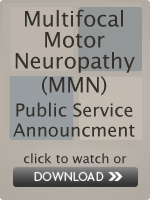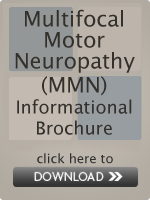

What is Multifocal Motor Neuropathy?
By Jonathan Katz, MD and Richard Lewis, MD
Multifocal Motor Neuropathy (MMN) is a rare condition in which multiple motor nerves are attacked by one’s immune system. This causes weakness without loss of sensation. The specific nature of the attack is unique and perplexing, since motor and sensory fibers are intermingled within the nerve trunks of the arms and legs, but only the motor nerves become involved.
To understand MMN it is important to understand how nerves transmit impulses. Nerve fibers are similar to electric wires, in that they are composed of axons (the wires) and myelin (the insulation). Unlike wires, however, the myelin is spaced along the nerves with gaps called Nodes of Ranvier. These nodes sit between segments of nerve that are wrapped with myelin. Nerves propagate electrical current, called action potentials by “jumping” from one Node of Ranvier to the next. This remarkable arrangement allows microscopic axons to transmit impulses at very high speeds; in adult humans, at rates of 50 meters/second.
A defining feature of MMN is conduction block; Conduction block is when the impulse fails to travel all the way down the nerve. There are many reasons for this but the exact one responsible in MMN is unknown. The encouraging aspect of conduction block is that it is potentially reversible, restoring function without any significant long term effects.
In MMN, it is thought, although not proven, that antibodies directed against a constituent of the Node of Ranvier (GM 1 ganglioside) cause the sodium channels at the nodes to stop functioning.
Although conduction block is reversible, continued attacks on the nodes can cause destruction of the myelin and axons. These different mechanisms explain why some people with MMN respond to therapy very quickly, while others may develop prolonged or permanent weakness and shrinking of muscles from damage to the nerve (atrophy). As such, the goals of any treatment are to prevent the axonal degeneration and reverse the conduction block.




